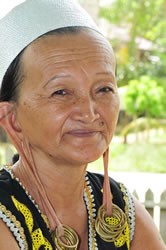Dayak, Kendayan in Malaysia

Photo Source:
MySabah.com
Used with permission
|
Send Joshua Project a map of this people group.
|
| People Name: | Dayak, Kendayan |
| Country: | Malaysia |
| 10/40 Window: | Yes |
| Population: | 17,000 |
| World Population: | 415,000 |
| Primary Language: | Kendayan |
| Primary Religion: | Ethnic Religions |
| Christian Adherents: | 10.00 % |
| Evangelicals: | 0.40 % |
| Scripture: | Portions |
| Ministry Resources: | No |
| Jesus Film: | Yes |
| Audio Recordings: | Yes |
| People Cluster: | Borneo-Kalimantan |
| Affinity Bloc: | Malay Peoples |
| Progress Level: |
|
Introduction / History
The Bidayuh are the third largest indigenous community in Sarawak after the Iban and the Malay. They include six main dialectical subgroups: Bau-Bidayuh, Biatah-Penrissen, Bukar-Sadung, Padawan-Sembaan, Rara, and Salako. All the subgroups were collectively called Land Dayak in the past but were officially named Bidayuh by government action in 2002. One of these Land Dayak groups are the Kendayan Dayaks, defined by their language, Kendayan.
Their traditional homeland was in the southwestern tip of Sarawak with ninety-three percent living in the Kuching Division and another seven percent in the nearby Samarahan Division. More recently there has been increasing movement of the young, especially those with vocational or professional skills, to other parts of Sarawak. Significant numbers are now found in the towns of Miri, Sibu, and Bintulu.
What Are Their Lives Like?
The Kendayan Dayak were traditionally longhouse dwellers who made their living by subsistence farming. In recent years many have abandoned longhouses for single houses within villages, but many aspects of their traditional culture and social organization have been retained. Rice farming is still an important part of their culture and economy. The agricultural cycle is marked by important festivals called Gawai. Their way of life is structured by their adat (customary law). There is a strong sense of cooperation and communal sharing that goes back to the longhouse culture. Economic development and education have brought many of the Kendayan Dayak into the mainstream of modern Sarawak society, but they have managed to maintain many distinct aspects of their culture.
What Are Their Beliefs?
Traditionally, the Kendayan Dayak were animists with some influence from Hinduism and Buddhism. While they attribute spirits to many things in nature such as birds, animals, and plants, many who hold to the traditional religion today believe in a supreme god who comes to their assistance in the cycle of rice cultivation as well as major events in the cycle of life.
Many of the Kendayan Dayak have become Christians. Although many have come to sincerely believe the good news and do attend church, some remain nominal.
What Are Their Needs?
While many of the Kendayan Dayak have experienced the benefits of an improved educational system and the modern economy, the rural Kendayan Dayaks in particular are not experiencing the same level of progress. For those in the mainstream of modernization, there is a challenge to maintain their cultural heritage and identity.
There is growing interest in developing their language for use in schools. Translation of the good news has been done in one dialect, and there is interest in doing so for other dialects.
Prayer Points
Pray that all Dayaks would have access to education and the benefits of an improved economy, and that they would have access to the good news, whether they are from traditional or church backgrounds, so their lives could be transformed.
Pray for the Lord to bless them economically and spiritually, showing them that God is all-powerful and all-loving.
Pray for Kendayan Dayak disciples to make more disciples.